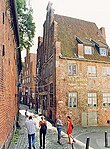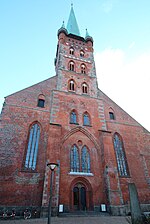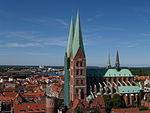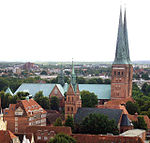Lübeck Hauptbahnhof

Lübeck Hauptbahnhof (German for Lübeck main station) is the main railway station serving the Hanseatic city of Lübeck, in the German state of Schleswig-Holstein. It is a through station at the western edge of the city centre. With around 31,000 travelers and visitors each day, Lübeck Hbf is the busiest of all the railway stations in Schleswig-Holstein. It is classified by the Deutsche Bahn as a category 2 station. The present station building was built in 1908 by the Lübeck-Büchener Eisenbahn (LBE). At that time, the LBE operated most of the railway connections around Lübeck, including the express trains. The station building was designed by Fritz Klingholz, and replaced the previous, outdated building. Lübeck Hbf is a Reiterbahnhof, or station with a reception building laid out as a bridge "riding" over the tracks. Its reception building spans a total of 10 tracks with four platforms. A special feature is its wide wooden steps leading down to the platforms. The station was recently modernised and completely electrified, and is now fully connected with Germany's electric railway network.
Excerpt from the Wikipedia article Lübeck Hauptbahnhof (License: CC BY-SA 3.0, Authors, Images).Lübeck Hauptbahnhof
Am Bahnhof, Lübeck Sankt Lorenz Süd (Sankt Lorenz Süd)
Geographical coordinates (GPS) Address Nearby Places Show on map
Geographical coordinates (GPS)
| Latitude | Longitude |
|---|---|
| N 53.867222222222 ° | E 10.669166666667 ° |
Address
Lübeck Hbf
Am Bahnhof 6
23558 Lübeck, Sankt Lorenz Süd (Sankt Lorenz Süd)
Schleswig-Holstein, Germany
Open on Google Maps










